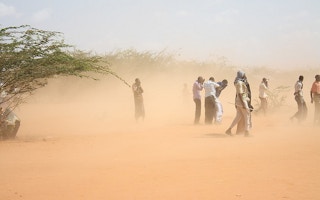The biggest and worst droughts may not stay fixed in one place but can travel thousands of kilometres from their origin, according to a new study.
And that discovery, disturbing as it may sound, could shed light on how droughts evolve in space and time, provide new insights for water managers, and save huge numbers of lives.
The UN says that drought affected more than one billion people between 1994 and 2013. In the 1983 Ethiopian drought, 300,000 are thought to have died, and three million people died in China’s 1928 drought.
Researchers in Austria and the US report in Geophysical Research Letters journal that they have found that a few of the most intense droughts travel across continents in predictable patterns.
Their study could help improve projections of future droughts, allowing for more effective planning.
While most droughts tend to stay put near where they started, the study found that about 10 per cent travel between 1,400 and 3,100 kilometres – with the distance depending on the continent where they develop.
Potential for damage
These travelling droughts tend to be the largest and most severe ones, with the highest potential for damage to agriculture, energy, water, and people.
“Most people think of a drought as a local or regional problem, but some intense droughts actually migrate, like a slow-motion hurricane on a timescale of months to years instead of days to weeks,” says Julio Herrera-Estrada, a PhD candidate in civil and environmental engineering at Princeton University, US, who led the study.
The researchers analysed drought data from 1979 to 2009, identifying 1,420 droughts worldwide. They found hotspots on each continent where a number of droughts had followed similar tracks.
“
Most people think of a drought as a local or regional problem, but some intense droughts actually migrate, like a slow-motion hurricane on a timescale of months to years instead of days to weeks.
Julio Herrera-Estrada, PhD candidate, civil and environmental engineering, Princeton University
For example, in the southwestern US, droughts tend to move from south to north. In Australia, the researchers found two drought hotspots and common directions of movement, one from the east coast in a northwest direction, the other from the central plains towards the northeast.
What causes some droughts to travel remains unclear, but the data suggest that feedback between precipitation and evaporation in the atmosphere and on land may play a role.
“This study also suggests that there might be specific tipping points in how large and how intense a drought is, beyond which it will carry on growing and intensifying,” says Justin Sheffield, professor of hydrology and remote sensing at the University of Southampton, UK, who was Herrera-Estrada’s adviser while serving as research scholar at Princeton.
Better predictions
Although the initial onset of a drought remains difficult to predict, the new model could enable researchers to make better predictions of how droughts will develop and persist.
“This study used an innovative approach to study how droughts evolve in space and time simultaneously, to have a more comprehensive understanding of their behaviours and characteristics, which has not been possible from previous approaches,” says Yusuke Satoh, a research scholar on the International Institute for Applied Systems Analysis (IIASA) water programme, who also worked on the study.
The study also raises the importance of regional co-operation and of sharing information across borders, whether state or national.
One example is the North American Drought Monitor, which brings together information from Mexico, the US and Canada, creating a comprehensive real-time monitoring system.
The researchers say the next step for their work is to examine why and how droughts travel by studying the feedback between evaporation and precipitation in greater detail. Herrera-Estrada also wants to analyse how drought behaviour may be affected by climate change.
This story was published with permission from Climate News Network.










